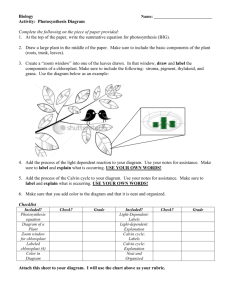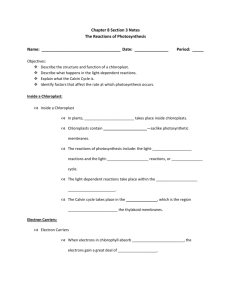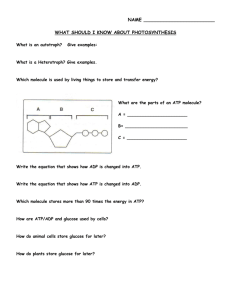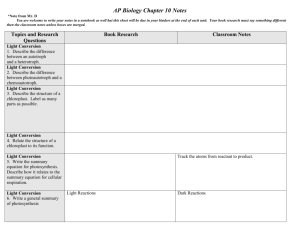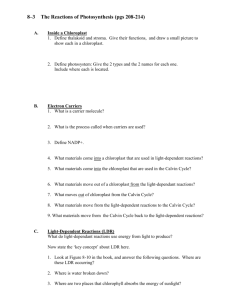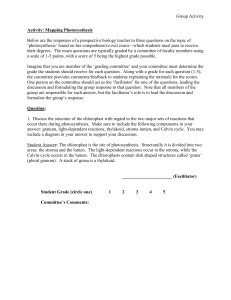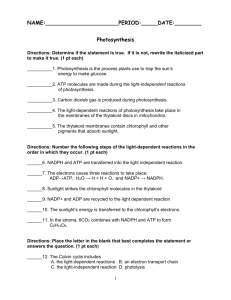Photosynthesis
advertisement
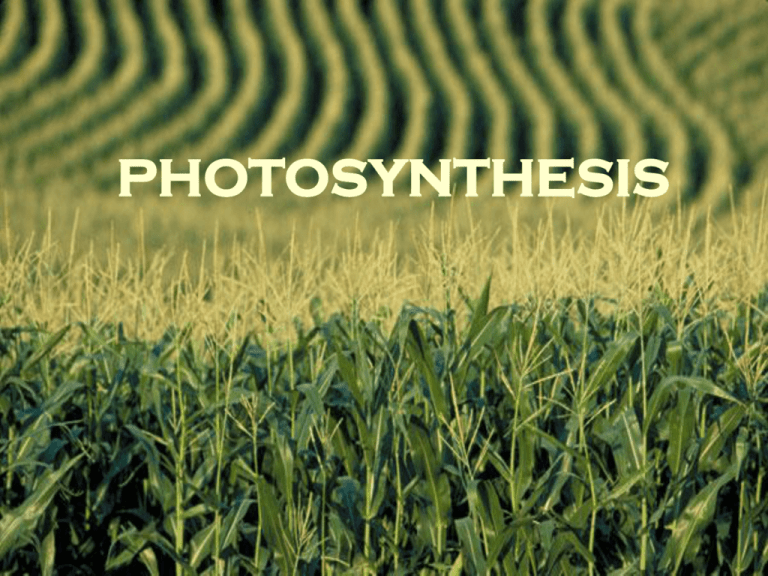
PHOTOSYNTHESIS 6CO2 + 6H2O C6H12O6 + 6O2 Objectives: Students will be able to: 1. Explain that white light is composed of multiple colors. Lesson 1: Objectives 2. Understand that different colors of light have different wavelengths (λ) and different amounts of energy (E). 3. List the colors of the visible light spectrum. 4. Identify which color of light has the most energy/least energy. The Energy of Light Visible Light Spectrum o Sunlight is composed of colors with different wavelengths – ROY G BIV – Inverse relationships proof: E = hc/λ E = energy h = Planck’s constant, c = speed of light λ = wavelength -Longer wl (red/orange) = low energy -Shorter wl (violet/indigo) = greater energy Electromagnetic Spectrum Read pages 206-214 -Create an outline of the chapter & write basic notes -Be prepared for a drill based upon your HW Monday March 28, 2011: Drill 1) What materials come into the chloroplast that are used in the light-dependent reactions? 2) What material comes into the chloroplast that is used in the Calvin cycle? 3) What materials move out of the chloroplast from the light-dependent reactions? 4) What materials move out of the chloroplast from the Calvin cycle? 5) What materials move from the light-dependent reactions to the Calvin cycle? 6) What materials move from the Calvin cycle back to the light-dependent reactions Monday March 28, 2011: Drill Answers 1) What materials come into the chloroplast that are used in the light-dependent reactions? Light and water 2) What material comes into the chloroplast that is used in the Calvin cycle? Carbon dioxide 3) What material moves out of the chloroplast from the light-dependent reactions? oxygen 4) What material(s) move out of the chloroplast from the Calvin cycle? Sugars 5) What materials move from the light-dependent reactions to the Calvin cycle? NADPH and ATP 6) What materials move from the Calvin cycle back to the light-dependent reactions? NADP+ and ADP + P Objectives Students will be able to: 1. Understand that light energy can be converted into other forms of energy. 2. Explain the THREE options for light energy when it meets an object. 3. Define pigment. 4. Identify THREE pigments found in plants and tell which colors of light each pigment absorbs. Absorbed Transmitted Reflected Lab tomorrow : goggles & apron Read laboratory packet View pre-lab video on YouTube http://www.youtube.com/watch?v=THqmpLd UaBA&feature=related "Electromagnetic Spectrum." 25 January 2010 <http://www.optics.arizona.edu/Nofziger/UNVR195a/Class12/EMspectrum1.gif>. Ronk. "My Perpetual Motion Machine." 20 September 2009. Weekends in Paradelle. 27 January 2010 <http://paradelle.files.wordpress.com/2009/09/crookes_radiometer.jpg?w=210&h=273>. "work." The American Heritage® New Dictionary of Cultural Literacy, Third Edition. Houghton Mifflin Company, 2005. 26 Jan. 2010. <Dictionary.com Thursday March 31, 2011 Class: -Review Quiz -Discuss Lab Report (title page, introduction, procedure, biblio) PHOTOSYNTHESIS lecture HW: Chromatography questions due Friday April 1, 2011 Chemistry Placement Exams Friday April 1, 2011 Lab Report Photosynthesis due Wednesday April 6, 2011 Photosynthesis • Method of converting sun energy into chemical energy (organic compounds-glucose) usable by cells • In specialized structures of plant cells called chloroplasts -Light absorbing pigment molecules e.g. chlorophyll • Autotrophs: organisms capable of making their own food – Photoautotrophs: use sun energy e.g. plants & photosynthesis – Chemoautotrophs: use chemical energy e.g. bacteria that use sulfide or methane chemosynthesis-makes organic compounds from chemical energy contained in sulfide or methane • 6CO2 + 6 H2O + light energy → C6H12O6 + 6O2+ 6H2O • Carbohydrate made is glucose • H2O is split as a source of e- from hydrogen atoms releasing O2 as a byproduct • E- increase potential energy when moved from water to sugar therefore energy is required Light-dependent Reactions Overview: light energy is absorbed by chlorophyll molecules-this light energy excites electrons and boosts them to higher energy levels. They are trapped by electron acceptor molecules that are poised at the start of a neighboring transport system. The electrons “fall” to a lower energy state, releasing energy that is harnessed to make ATP Tuesday 4/5/2011 Drill 1) Which reaction occurs in the chloroplast? 2) What is the purpose of the stoma? 3) What is the product of the light-dependent reaction? 4) Which electron carriers are generated and move from the light dependent reactions to the light-independent reactions? Light-dependent Reactions • Photosystem: light capturing unit, contains chlorophyll, the light capturing pigment • e- transport system: sequence of e- carrier molecules that shuttle e-, energy released to make ATP • e- in chlorophyll must be replaced so that cycle may continue-these electrons come from water molecules, oxygen is liberated from the light reactions • Light reactions yield ATP and NADPH used to fuel the reactions of the Calvin cycle (light independent or dark reactions) Calvin Cycle aka Light-Independent Reaction/Dark Reaction ATP and NADPH generated in light reactions fuel the reactions to break apart CO2 & reassemble the carbons into C6H12O6 Carbon fixation: taking C from an inorganic molecule (atmospheric CO2) to produce an organic molecule (C6H12O6) PHOTOSYNTHESIS ANIMATION photosynthesis animation • http://www.ftexploring.com/me/photosyn1.html True/False Photosystem II follows Photosystem I True/ False Chlorophyll absorbs green wavelengths and carotene reflects them True/False NADPH and ATP are generated during the light-dependent reactions and used in the dark reactions True/False The Calvin cycle cannot take place in the path of sunlight True/False The stoma is the exit/entry point into the leaf and the stroma is the site of the lightindependent reaction True/False I DON’T HAVE A CLUE WHAT’S GOING ON WITH ALL THE CONVERTED FORMS OF ENERGY FROM SUNLIGHT!!! Small groups of students should each place a sprig of elodea (an underwater plant often used in household aquariums) into a test tube. Cut the stem of the plant at an angle so that students can see the cross-section of the stem. Add a pinch of baking soda to the test tube, then place the tube into a beaker filled with water. Finally, place the whole assembly under a heat lamp. Within 10 minutes, students will start to see bubbles rising from the end of the stem; the plant is producing oxygen, indicating photosynthes Read more: Photosynthesis Activities for High School | eHow.com http://www.ehow.com/list_6063372_photosyn thesis-activities-highschool.html#ixzz1nAtNjusb
